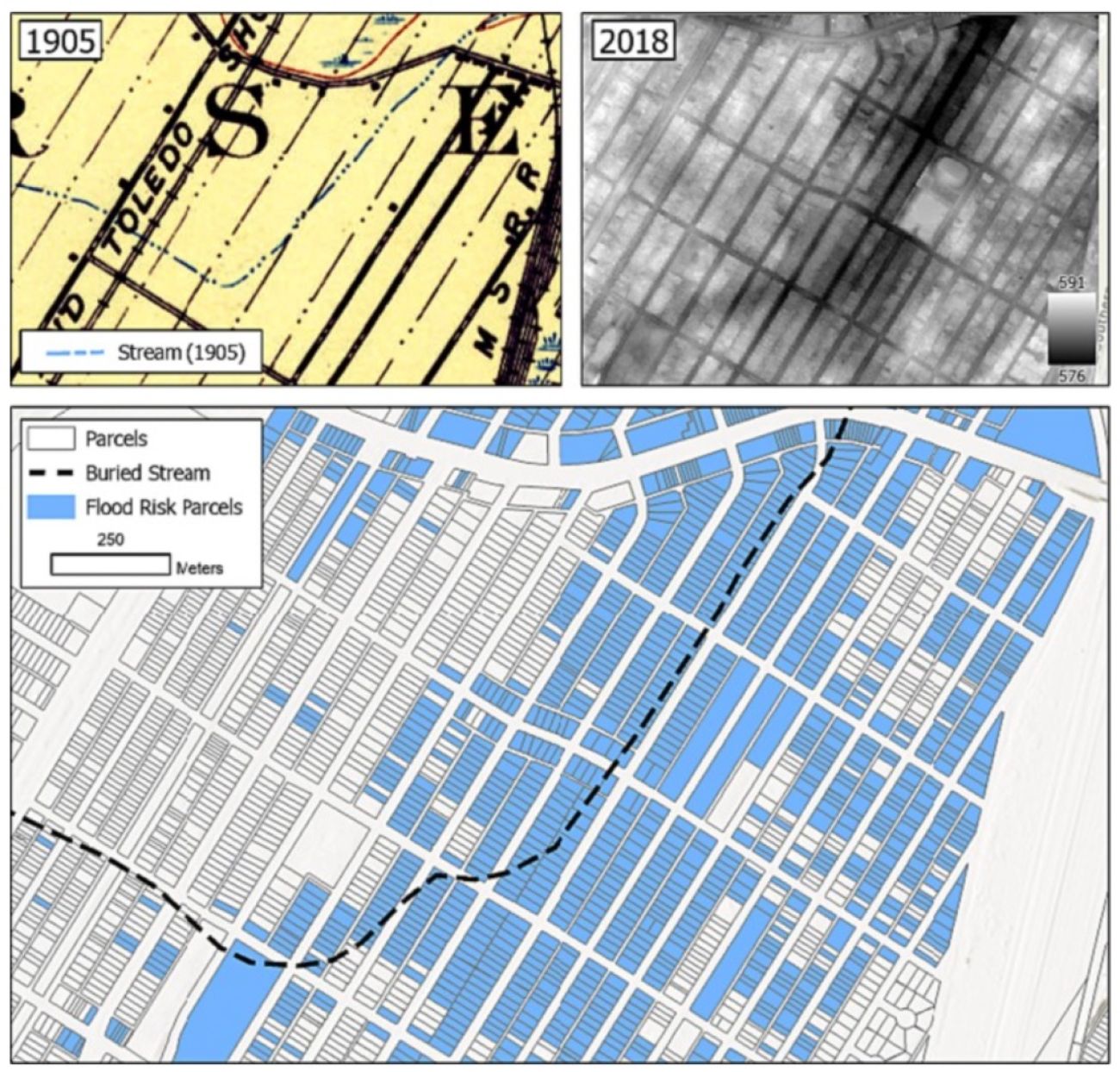Detroit’s ‘ghost’ streams can be a threat in the present

Setting out by foot or by bike, Joanne Coutts has mapped more than 200 miles of buried creeks and wetlands across Detroit’s landscape over the last year-and-a-half.
Her work is part of a growing interest in buried and forgotten historical waterways to better inform water and flood management in the present. When heavy rain pours, buried ghost streams flow, contributing to flooding in Detroit’s most vulnerable neighborhoods and causing significant damage, University of Michigan-Dearborn researchers found.
Since 1905, 85% of the city’s historic streams have been buried for urban development, leading to long-term ramifications for Detroit’s most vulnerable residents.
These streams and wetlands are a little-examined flood risk, according to a new study published in City and Environment Interactions. Using historical maps to identify once-active waterways, researchers compared the streams to flood risk data and historic Home Owners’ Loan Corporation redlining maps, finding that flooding disproportionately impacts redlined neighborhoods.
The presence of these ghost streams contributes to the risk, along with reduced vegetation density and proximity to industry associated with redlined neighborhoods, according to the research.
Related:
- Detroit area redistricting effort continues: Five things to know
- Detroit Lions playoff run means higher prices next year beyond tickets
- Michigan’s population crisis dominates Detroit Policy Conference
“Sometimes people are subjected to flood risk and they don’t even know why, and it could have something to do with history,” said Jacob Napieralski, lead author of the study and a geology and geographic information systems professor at the University of Michigan-Dearborn.
“The landscape doesn’t really forget, it has a memory, and when it’s time, water will occupy those spots,” Napieralski said.

In the 1930s, the federal government drew red lines around neighborhoods it felt were too risky for mortgage loans – the basis was often whether people of color lived there – and the neighborhoods were given rankings from “A” to “D,” with “D” being the most risky.
Napieralski’s research team found that in metro Detroit, 96% of extreme flood risk is concentrated in neighborhoods that were rated “C” and “D,” while just 3.9% are in “A” and “B” neighborhoods.
A number of confounding factors associated with redlining increase flood risk and drive health concerns.
Redlined neighborhoods are more likely to host industry that, when it rains, can cause contaminants to be mixed in with floodwater. They found that more than a fourth of Detroit’s formerly redlined neighborhoods are now zoned for industry, compared to 0% of neighborhoods that received the grade “A.”
They also found that residents in redlined neighborhoods are less likely to have flood insurance and vegetation like rain gardens and trees, which can mitigate flooding.
Napieralski said it’s important that cities start mapping this hidden hydrology to fully inform residents about their flood risk and make decisions about flood mitigation investment. It adds to previous research which found that 43% of Detroiters have experienced flooding and that very old and very new homes were the most likely to be impacted.
Several similar projects in recent years across the country show renewed interest in mapping historical waterways
In 2015, Lars Graebner, a principal at VolumeOne Design Studio, made a map of historic waterways in Detroit.
Coutts, a Detroit cartographer and activist, took mapping one step further by going in-person to map the creeks and capture the human and natural nuance of landscapes that online mapping tools obliterate, she said. So far, she’s traveled 217 miles along the historic creeks and waterways, documenting when she sees things related to water, like cattails or a boat.
As a newcomer to Detroit, she wanted to orient herself to the city through waterways.
“A lot of times, how you get from one place to another is guided by concrete and by freeways,” she said. “I wanted to think about how learning about the watercourses could help me orient and navigate the city in a way that was centered around water and the intrinsic nature of the land.”
Coutts said that by being on the ground and physically mapping the historic streams, she has firsthand insight into areas that might be prime for revegetation, and is hoping to begin collaborating with others working in the space to mitigate flooding.
“I’ve seen areas where the land and the plants are sort of resisting, coming back and breaking through the sidewalks and the roads and how that information, by being connected to the actuality of the environment in different places today, can be used.”
Michigan Environment Watch
Michigan Environment Watch examines how public policy, industry, and other factors interact with the state’s trove of natural resources.
- See full coverage
- Subscribe
- Share tips and questions with Bridge environment reporter Kelly House
Michigan Environment Watch is made possible by generous financial support from:
Our generous Environment Watch underwriters encourage Bridge Michigan readers to also support civic journalism by becoming Bridge members. Please consider joining today.
See what new members are saying about why they donated to Bridge Michigan:
- “In order for this information to be accurate and unbiased it must be underwritten by its readers, not by special interests.” - Larry S.
- “Not many other media sources report on the topics Bridge does.” - Susan B.
- “Your journalism is outstanding and rare these days.” - Mark S.
If you want to ensure the future of nonpartisan, nonprofit Michigan journalism, please become a member today. You, too, will be asked why you donated and maybe we'll feature your quote next time!






